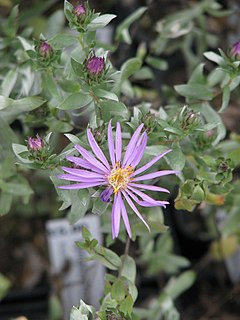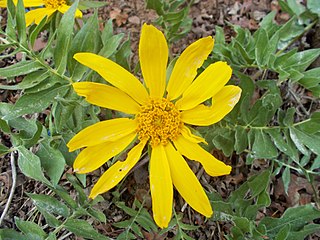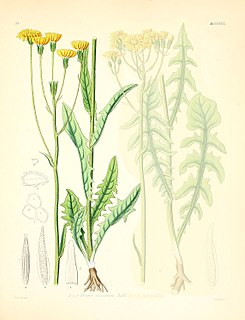
Eurybia macrophylla, commonly known as the bigleaf aster, large-leaved aster, largeleaf aster or bigleaf wood aster, is an herbaceous perennial in the family Asteraceae that was formerly treated in the genus Aster. It is native to eastern North America, with a range extending from eastern and central Canada through the northeastern deciduous and mixed forests of New England and the Great Lakes region and south along the Appalachians as far as the northeastern corner of Georgia, and west as far as Minnesota, Missouri and Arkansas. The flowers appear in the late summer to early fall and show ray florets that are usually either a deep lavender or violet, but sometimes white, and disc florets that are cream-coloured or light yellow, becoming purple as they mature. It is one of the parent species of the hybrid Eurybia × herveyi.

Symphyotrichum laeve is a flowering plant native to Canada, the United States, and Coahuila (Mexico). It has the common names of smooth blue aster, smooth aster, smooth-leaved aster, glaucous Michaelmas-daisy and glaucous aster.

Balsamorhiza is a genus of plants in the family Asteraceae known commonly as balsamroots. These are perennials with fleshy taproots and caudices bearing erect stems and large, basal leaves. Atop the tall stems are showy yellow sunflower-like blooms. Balsamroots are native to western North America.

Erigeron strigosus is a species of flowering plant in the family Asteraceae known by the common names prairie fleabane, common eastern fleabane, and daisy fleabane.

Eupatorium hyssopifolium, also known as hyssopleaf thoroughwort, is a fall-blooming herbaceous plant native to North America. Like other members of the genus Eupatorium it has inflorescences containing a large number of very small flower heads, each with 5 white disc florets but no ray florets. At 0.5 to one meter tall, it is towards the shorter end of the range of heights found in Eupatorium species.

Symphyotrichum sericeum is a species of flowering plant in the family Asteraceae native to central North America. Commonly known as western silver aster, western silvery aster, and silky aster, it is a perennial, herbaceous plant that may reach 70 centimeters tall. Its flowers have purple ray florets and pink then purple disk florets, and its leaves are firm and silvery-green.

Balsamorhiza deltoidea is a species of flowering plant in the sunflower tribe of the plant family Asteraceae known by the common name deltoid balsamroot. It is native to western North America from British Columbia to California, where it grows in many types of generally mountainous habitat.
Balsamorhiza macrolepis is a species of flowering plant in the tribe Heliantheae of the family Asteraceae, known by the common name California balsamroot. It is found only in California, where it grows in dry, open habitat, mostly in mountainous areas, mostly in the western foothills of the Sierra Nevada and in the eastern Coast Ranges near San Francisco Bay. It is now becoming rare in the Coast Ranges.

Balsamorhiza sagittata is a North American species of flowering plant in the tribe Heliantheae of the family Asteraceae known by the common name Arrowleaf Balsamroot. It is widespread across western Canada and much of the western United States. A specimen was collected by explorer and botanist Meriwether Lewis near Lewis and Clark Pass in 1806.

Balsamorhiza sericea is a species of flowering plant in the tribe Heliantheae of the family Asteraceae known by the common name silky balsamroot. It is native to the Klamath Mountains of northwestern California and southwestern Oregon, with additional populations in the Blue and Steens Mountains in eastern Oregon. It grows in rocky areas, sometimes on serpentine soils.

Bidens aristosa is a North American species of plants in the sunflower family. Common names include bearded beggarticks, western tickseed, long-bracted beggarticks, tickseed beggarticks, swamp marigold, and Yankee lice. It is native to eastern and central United States and south-central Canada, from Maine south to Florida and west as far as Ontario, Texas, and Nebraska. It grows in wet meadows and abandoned fields.

Heliopsis helianthoides is a species of flowering plant in the family Asteraceae, known by the common names rough oxeye, smooth oxeye and false sunflower. It is native to eastern and central North America from Saskatchewan east to Newfoundland and south as far as Texas, New Mexico, and Georgia.

Ratibida pinnata is a species of flowering plant in the family Asteraceae known by the common names pinnate prairie coneflower, gray-head coneflower, yellow coneflower, and prairie coneflower. It is native to the central and eastern United States and Ontario in Canada.

Balsamorhiza hispidula is a North American species of plants in the sunflower tribe within the aster family. It is native to western United States, primarily the Great Basin and other dry, relatively flat terrain. It has been found in Idaho, Montana, Wyoming, Oregon, Nevada, Colorado, Utah, and Arizona.
Balsamorhiza rosea is a North American species of plants in the sunflower tribe within the aster family. It is native to the northwestern United States, in Washington and Oregon.

Balsamorhiza macrophylla is a North American species of plants in the tribe Heliantheae of the family Asteraceae. The species is native to the northwestern United States, in Idaho, Montana, Wyoming, Utah, and Oregon. It grows in sagebrush scrublands and conifer forests. It sometimes hybridizes with Balsamorhiza sagittata.
Balsamorhiza serrata is a North American species of plants in the tribe Heliantheae of the family Asteraceae.
Balsamorhiza lanata, with the common name lanate balsamroot, is a species of plant in the tribe Heliantheae of the family Asteraceae native to California.

Crepis nicaeensis is a European species of flowering plant in the family Asteraceae with the common names French hawk's-beard and Turkish hawksbeard. It is widespread across much of Europe, as well as being sparingly naturalized in scattered locations in the United States and Canada.

Symphyotrichum patens, commonly known as late purple aster or spreading aster, is a perennial, herbaceous plant found in the eastern United States.
















